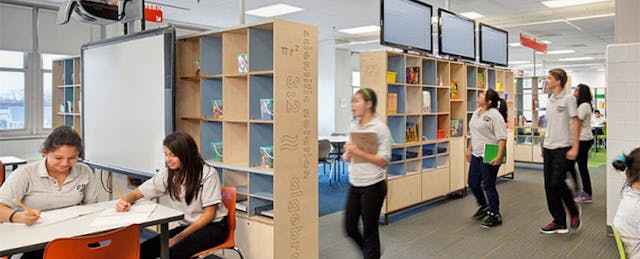When Joel Rose, co-founder of the nonprofit NewClassrooms, created the “Teach to One: Math” program in 2011, he envisioned a math classroom where students learn math via multiple modalities. Rose’s program was built on the notion that students learned differently, and it seemed promising given Rose’s experience with creating more personalized instructional programming with the New York City Department of Education. But as with many new programs, there was no evidence of Teach to One’s “effectiveness,” as neither students nor researchers had yet taken a crack at the Teach to One (TtO) model.
Fast-forward to November 2013; today, Columbia University's Teachers College releases a study on the effectiveness of Teach to One. The program has served over 3,000 students in seven schools for a full year. Now data from tracking approximately 2,200 TtO students has been collected and analyzed. The conclusion? Teach to One does provide small gains on math competencies for a majority of student subgroups—but not for all.
WIth its current population of 3,500 students, Teach to One is a unique approach to instructional design for the math classroom.
Since 2011, Teach to One has endeavored to individualize learning for every math student. Students can rotate among eight learning modalities, including peer-to-peer work, independent practice, teacher-led instruction, and coached virtual instruction. Essentially, students have the ability to visit various math “stations” during class time. All the while, the TtO central office staff “observes and generates unique solutions for students,” according to Rose. Unique math activity schedules are generated day-to-day based on each student’s data from the day before, in order to ensure that students receive as personalized of instruction as possible.
Today, Teachers College’s Center for Technology and School Change releases its initial findings on the outcomes of the Teach to One program. The study tracked 2,264 students who attended schools participating in the TtO program in Chicago, NYC, or Washington, DC) and analyzed their growth on the MAP (Measures of Academic Progress) math assessment.
On the positive side, the average gains of TtO students in sixth, seventh, and eighth grade surpassed those made by students nationally. Upon entering the program, incoming TtO students were performing at an average of 4.7 MAP points lower than the national average. Yet despite these discrepancies, nine months later, the average MAP score point gain of TtO students (in all three of the middle school grade levels) rose higher than national average gains. TtO sixth graders showed the largest improvement: they gained an average of 7.1 points on their MAP scores while sixth graders from across the country averaged a 6-point gain.
Though small, the improved performance appears more significant when considering the relatively disadvantaged backgrounds of TtO youth. In fact, the improvements extend to particular subgroups, reflecting some of the largest demographics in the seven urban schools.
“The performance of English Language Learners (ELL) and special education (SPED) students is incredibly encouraging to us. Students progress based on their position, when they have mastered the skill taught,” says Rose, citing that ELL learners performed against the national average in a “points gained” ratio of 1.24 to 1, while SPED students came out 1.09 to 1.
Specific racial subgroups also boasted large gains than the national average. Asian, Hispanic, and white subgroups performed at ratios of 1.46, 1.39, and 1.24, respectively, greater than their traditional-school counterparts.
However, despite the positive outcomes, not all of the study’s findings fell within the realms of “effective.” The study cautions that “student gains were uneven across Teach to One schools, and grade level averages varied considerably.” This is extremely noticeable when looking at discrepancies in overall point gains between School A (where eighth graders gained an average of 10.84 points) and School G (where the average gain was only 0.37 points). Additionally, black students’ MAP score gains across the seven schools fell short of the national average, at a ratio of 0.90 to 1.
Perhaps even more surprising was the performance of those students who came in “at grade level” and “above grade level” prior to engaging in the TtO program. “At grade level” students gained virtually the same amount of growth as the national average. “Above grade level” students performed even worse, falling short of the national average with a ratio of 0.89 to 1.
Rose has been careful to note the areas for TtO’s furthered improvement particularly as the program grows. This year, more than 6,000 students will engage in the TtO program, nearly double the number of students from the year before.
Rose believes that this issue was linked to hesitation on the TtO staff’s part to aggressively challenge the higher-performing students. “We have come to believe that we were simply too conservative in how we generated unique schedules for [the above average] student population,” Rose admitted. “Recently, we’ve been more aggressive with our progressions.” What does this look like in practice? High-scoring students will rotate to more challenging, high-level activities at a quicker pace.
By all intents and purposes, the Teach to One program is still a relatively new method of teaching math, one ripe for improvements. And as a result, Rose is anything but fazed by this data.
“We have a lot to learn, and a lot to improve upon,” Rose declares. “We’re not focused on a number. We're focused on getting it right.”


